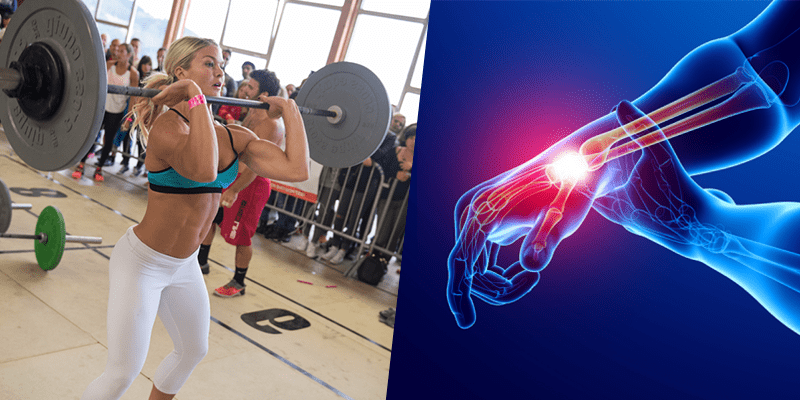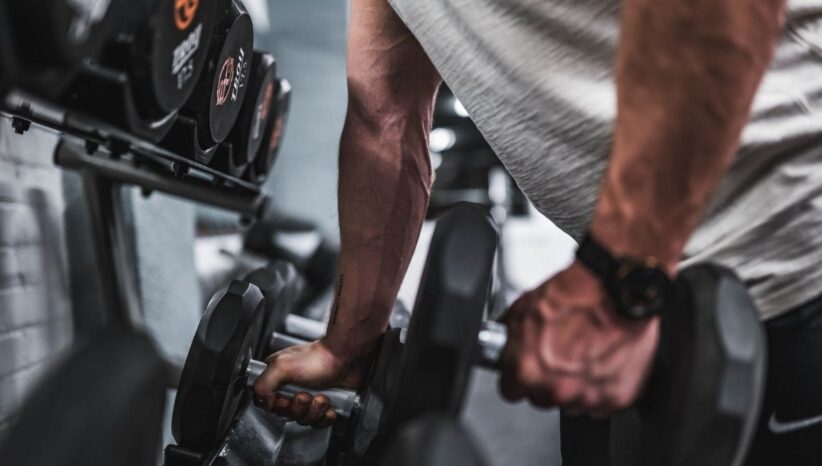This complete guide will teach you everything you need to know about Wrist Curls.
What are Wrist Curls?
Wrist curls are an isolation exercise that strengthen the wrist and forearms. More specifically, wrist curls target the wrist extensor and flexor muscles.
Unlike other arm exercises that also work larger muscle groups (like biceps), wrist curls focus on exercising only one muscle group at a time.
- What are Wrist Curls?
- What Muscles do Wrist Curls Work?
- What are the Benefits of Wrist Curls?
- How to Do Wrist Curls
- Wrist Curl Alternatives
- Wrist Curl Variations
- Wrist Curls Common Mistakes
- Are Dumbbells or Barbells Better for Wrist Curls?
- Is an Overhand or Underhand Grip Better for Wrist Curls?
- How Can you Prevent Sore Wrists when Weightlifting?
- Do Wrist Curls Do Anything?
- Are Reverse Wrist Curls Worth it?
- Can Wrist Curls Hurt your Wrists?
- Why are Strong Wrists Important?
- Summary
- Learn More
What Muscles do Wrist Curls Work?
Wrist curls exercise primarily work the following muscles:
- Forearms
- Wrist flexors
- Wrist extensors
- Brachioradialis muscle
The wrist curl exercise is an isolation exercise. This means that it involves one joint and works only one muscle group at a time.
What are the Benefits of Wrist Curls?
- Improves strength and muscle mass.
- Increases grip strength.
- Helps with blood circulation in the forearms.
- Can help prevent sore wrists when weightlifting (especially good to do before pulling exercises).
- Increases wrist flexibility, which can help prevent injury during other exercises such as deadlift or bench press (where you might be pressing a lot of weight).
How to Do Wrist Curls
The exercise can be performed with either a pronated or supinated grip.
- Sit on a bench and plant your forearms firmly on your knees
- Grasp the dumbbell with a supinated (palms up) grip, allowing it to hang down from your hand.
- Unhinge your wrist and slowly lower the dumbbell toward the floor as far as possible without placing stress on your wrist.
- Once you have reached the bottom of this range of motion, slowly raise the dumbbell back into starting by flexing at only the wrist joint.
- Repeat for desired repetitions.
Wrist Curl Alternatives
Add these into your training.
Wrist Curls with Resistance Bands
Stand on the middle of a resistance band or tube, holding an end in each hand. Knees should be slightly bent for balance and your arms extended downward, palms facing upwards (supinated), toward the ground.
Keeping elbows close to your sides, slowly bend at your wrists to curl the weight up until your hands are by your shoulders. Slowly straighten back out to starting position.
Reverse Wrist Curls
Grab a barbell or dumbbell, and place it on top of your thighs so that you’re holding onto it with both hands and it’s laying flat against your legs.
With palms facing down towards the ground (pronated), lift the weight upward by only bending at the wrists until they reach shoulder-height.

Then slowly return back down to starting position. You can do this exercise one arm at a time as well if you prefer more balance or less weight being used.
Reverse Wrist Curls with Resistance Bands
Do this exercise exactly as you would regular reverse wrist curls, but holding onto each end of a resistance band instead of using a barbell or dumbbell.
This makes it even more portable than normal reverse wrist curls since all you need is a cable machine!
Wrist Curls with a Machine
Sit in front of an adjustable pulley machine, attaching either a single D handle or V handle to one side.
Grab it from underhand grip (palms facing away from you) so that your arm is in line with that side’s low pulley cable set up; hold onto any available surface for support with your other hand/arm if necessary; then curve (curl) only at the wrist so that you bring the attached handle into contact with either shoulder/chest before returning back down to starting position
Wrist Curl Variations
- Wrist Curls with a Barbell
- Seated Wrist Curls
- Seated Reverse Wrist Curls
- Standing Wrist Curls
- Standing Reverse Wrist Curls
- Wrist Curls with Bands
- Wrist Curls with Cables
Wrist Curls Common Mistakes
- Do not lift the dumbbells too quickly or use momentum.
> You should be doing these slowly and with control.
- Do not use too much weight.
> If you’re using a weight that’s too heavy for you, you won’t be able to control the movement, and it won’t help you tone your forearms.
- Do not do this exercise without using a full range of motion.
> You should be moving the weights all the way down to your fingertips and back up again when doing wrist curls. Doing otherwise will only work some of your forearm muscles but not all of them, thus defeating the purpose of this exercise!
Are Dumbbells or Barbells Better for Wrist Curls?
Although dumbbells may seem more convenient, a barbell is actually the optimal choice for wrist curls.
With a barbell, you can use as little or as much weight as you want, simply by adding or removing weight plates from either end of the bar.
Dumbbells are less versatile in this regard; if your gym has a limited selection of weights or you’re doing the exercise at home, you might need to buy several pairs of dumbbells to get the right amount of resistance.
Additionally, using a barbell prevents the weight from rolling or falling on your body parts (or other people’s feet).
Is an Overhand or Underhand Grip Better for Wrist Curls?
It is important to note that wrist curls can be performed with either an underhand or overhand grip. However, most people find that their forearm muscles are better activated with an overhand or pronated grip, which is when the palms face down once you have grasped the barbell.
Performing wrist curls with an overhand grip places greater emphasis on the forearm flexors, which run along the top of your forearms and make up most of the size of your forearms.
The brachioradialis and brachialis muscles (which lie under your biceps) can also get involved in this movement just like they do during standard bicep curls.
A reverse wrist curl refers to a curl performed by using an underhand or supinated grip. This means that during the lift, your palms will be facing upwards. Using this grip activates your forearm extensors, which are used to straighten out your wrists/forearms.
You’ll see below some common exercises for each muscle group so you can get a better idea of how each group functions:
How Can you Prevent Sore Wrists when Weightlifting?
- Use wrist wraps. A good wrist wrap will offer some extra support for your wrists.
- Use the right technique. Make sure you’re performing the lift correctly, so that your wrists aren’t overly stressed.
- Use the right weights. Your wrists should be strong enough to handle the weight you’re lifting for an entire set of reps, so make sure that you’re not going above what’s reasonable for yourself during any given workout.
- Use a spotter. A spotter can help if a set is particularly difficult and you find yourself struggling with form as a result, so have one on hand if possible (and don’t forget to return the favour!).
- Take breaks in between sets and workouts. Give your body time to rest, rehydrate and recover in between sets or workouts—rushing through intense exercises without taking adequate breaks is just asking for trouble!
- Focus on your form as well as your weight instead of focusing only on your weight or how many reps you can bang out quickly. Form and technique are important even when it comes to strength training; doing exercises with poor form is a terrible idea!
- Use the right gear (like wrist wraps). The better equipped you are, the better results you’ll get from our workouts: don’t skimp on proper equipment like wrist wraps or other accessories!
- Work out more than just your biceps and triceps; incorporate some core-strengthening moves into each session too! The stronger your core muscles become over time, not only will lifting weights feel less strenuous but also other everyday tasks like carrying groceries home from work will become easier.”
Do Wrist Curls Do Anything?
Wrist curls do not directly work the abdominals, deltoids, biceps or triceps. However, they indirectly help these muscle groups by improving your ability to perform exercises that target them.
For instance, wrist curls allow you to accomplish more repetitions of chin-ups and bench presses because they strengthen the wrists, allowing you to use a stronger grip. Stronger muscles in your upper arms and shoulders also give you an edge when performing abdominal crunches.
Are Reverse Wrist Curls Worth it?
Reverse wrist curls are an excellent way to strengthen your wrists. They can help with rehabilitation and they’re a good way to improve grip strength or forearm strength as well.
They don’t require any equipment, so anyone can do them.
Can Wrist Curls Hurt your Wrists?
Wrist curls can be a great exercise for strengthening your wrists and forearms, but there are some things to watch out for.
The first is form and technique: you should have proper form and use good technique when doing this exercise in order to avoid injuries. Some of the things you should avoid that could hurt your wrists are:
- Holding too much weight
- Holding your breath
- Using jerky movements
- Arching your back
- Locking your elbows
- Twisting your wrists
- Going too fast
- Going too heavy
- Being too ambitious
Why are Strong Wrists Important?
Strong wrists are extremely important. They give you greater stability in your hands and arms, which is useful for a number of physical activities.
If you work with your hands—as a surgeon, mechanic, or maybe even as an artist—then having strong wrists will help to prevent fatigue and injury while giving you more control over the tools your job requires.
If you participate in sports that require throwing or capturing balls, then strong wrists will help you manage the impact of those balls when they come into contact with your body.
This is especially true for baseball players who often have to maintain their grip on bats through heavy impacts at high speeds.
Strong wrists also play an important role in weightlifting by helping to stabilize the weight being lifted and moved around the body.
Stronger wrists can allow you to lift heavier weights with less risk of injury; it’s common sense that a wrist can only support so much weight before breaking under pressure!
Summary
Wrist curls are popular exercises that target the muscles in the lower arm. Studies have shown they can increase muscular strength and endurance, which can lead to better performance.
Wrist curls also help you develop a strong grip, which is useful for sports like rock climbing and golf.
While wrist curls are fairly easy to do, there are some technical aspects of the exercise and variations that you should know about before getting started. For example, if you don’t have special equipment or strong wrists, performing wrist curls may be difficult or cause injury.
The Importance of Form
A proper technique is essential when performing wrist curls to avoid injury or wasting time on incorrect exercise execution.
The best way to perform this exercise is with a dumbbell or barbell specifically designed for this exercise.
If you don’t have access to specialized equipment, holding a dumbbell between your knees while seated may also work well for this exercise.
Learn More
Try the Inverted Row or Barbell Hip Thrust.
Take your fitness knowledge to the next level with BOXROX Pro.
Image Sources
- Forearm workouts: Anastase Maragos / Unsplash
